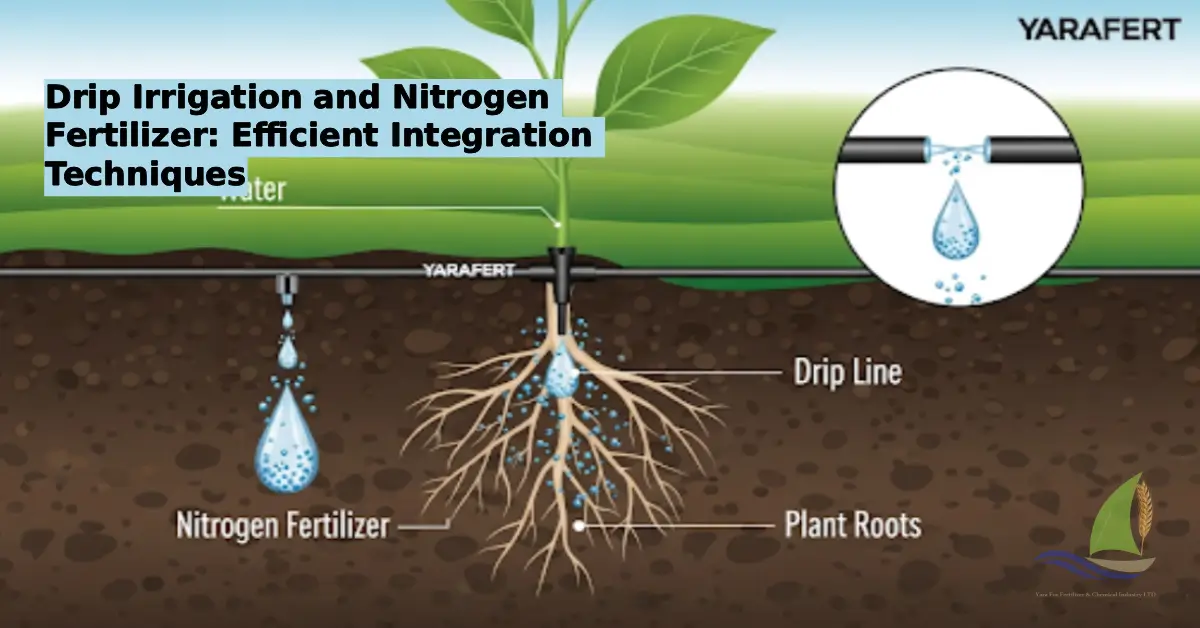Nitrogen fertilizer plays a central role in maximizing crop yield and quality. However, the method of delivery is just as important as the nutrient itself. Drip irrigation systems have emerged as one of the most effective ways to deliver nitrogen fertilizer directly to the root zone, reducing losses and improving efficiency. When combined with advanced formulations like YaraFert solutions and tailored blends such as SULPHOMIN or CALCIMAG, growers can achieve higher nutrient-use efficiency and healthier crops.
This guide explores how drip systems improve nitrogen delivery, practical methods of integration, crop-specific benefits, and best practices for preventing common issues such as clogging.
Why drip systems improve nitrogen fertilizer delivery
Traditional broadcast applications of nitrogen fertilizer often result in significant nutrient losses through leaching, volatilization, and runoff. Drip irrigation systems address these problems by targeting nutrients exactly where plants need them.
Key advantages of drip-fed nitrogen fertilizer include:

- Precision nutrient placement: Fertilizer is delivered directly into the root zone, minimizing waste.
- Improved uptake efficiency: Consistent low-dose applications align with crop growth stages.
- Reduced environmental impact: Lower risk of nitrate leaching into groundwater.
- Flexibility in nutrient combinations: Products like Biofast (NPK + humic and fulvic acids) integrate seamlessly into fertigation schedules.
By ensuring that nitrogen fertilizer reaches plants at the right time and in the right amount, drip systems make each kilogram of applied nutrient more effective.
How to mix nitrogen fertilizer into drip lines
Integrating nitrogen fertilizer into drip systems requires careful preparation to ensure compatibility and solubility. A proper mixing protocol prevents precipitation and guarantees smooth injection.
When preparing stock solutions:
- Use clean water – Avoid hard water with high bicarbonate levels that may react with nitrogen-based fertilizers.
- Dissolve fertilizers fully – Products such as Ugarit 27-27-27 + TE or Ugarit 40-10-10 + TE are designed for rapid dissolution.
- Check chemical compatibility – Do not mix phosphates and calcium-based fertilizers in the same tank to prevent clogging.
- Stir continuously – Keep suspension fertilizers like SULFOMIX well-agitated to ensure even distribution.
- Inject gradually – Maintain steady flow rates through fertigation pumps to avoid surges.



| Example Stock Solution | Nutrient Content | Notes for Use |
|---|---|---|
| SULPHOMIN | 45% N, 15% SO?, 25% organic matter | Enhances nitrogen efficiency while improving soil organic content |
| CALCIMAG | 15% N, 22% CaO, 3% MgO, 0.5% B | Supports calcium-sensitive crops like tomatoes and peppers |
| Biofast | 12-12-12 NPK + 24% humic & fulvic acids | Improves root vigor and nutrient chelation |
By following these steps, growers can safely integrate nitrogen fertilizer into their drip systems while ensuring nutrients remain available for plant uptake.
Preventing clogging with liquid nitrogen fertilizer

One of the most common challenges in fertigation is emitter clogging, especially when using suspension or high-viscosity fertilizers. Preventing blockages is essential for uniform distribution of nitrogen fertilizer.
Best practices to minimize clogging include:
- Filter maintenance: Install sand and screen filters, cleaning them regularly.
- Proper dilution: Thick fertilizers like Ugarit 25-25-25 + TE should be diluted before injection.
- Avoid chemical reactions: Do not mix calcium nitrate with sulfates in the same tank.
- Periodic flushing: Run clean water through the system after fertigation sessions.
- Acidic rinses: Occasional use of Phosphoric Acid 85% w/v (H?PO?, pH 1.5±0.5) helps dissolve carbonate deposits.


With preventive maintenance, farmers can maintain uninterrupted drip flow and maximize the return on investment from nitrogen fertilizer applications.
Scheduling nitrogen fertilizer injections through drip
The timing and frequency of nitrogen fertilizer application are crucial for maximizing plant uptake and reducing losses. Drip irrigation allows for “spoon-feeding” nutrients in alignment with crop growth stages.
A general fertigation schedule may look like this:
- Establishment phase: Apply a small amount of nitrogen (e.g., Ugarit 10-0-5 + 70% organic matter) to encourage root development.
- Vegetative growth: Increase nitrogen inputs with balanced NPK blends like Ugarit 27-27-27 + TE.
- Flowering stage: Shift towards potassium-rich formulations (e.g., Ugarit 10-10-40 + TE) while maintaining moderate nitrogen.
- Fruit filling and ripening: Use nitrogen-potassium fertilizers like Ugarit K-T-S 25 or Ugarit Multi to support fruit size and quality.
Drip fertigation makes it possible to match nutrient delivery precisely to physiological crop needs, enhancing efficiency while reducing waste.
Crop-specific benefits of nitrogen fertilizer via drip

Different crops respond uniquely to drip-applied nitrogen fertilizer. When combined with specialized formulations, the benefits extend beyond yield to quality and resilience.
Here are key examples:
- Cereals (wheat, corn): Products like Ugarit Cereal (15% N + 2% Cu) support robust tillering and protein synthesis.
- Fruit crops (grapes, strawberries): Ugarit Grapes and Ugarit Strawberry provide tailored micronutrient and P-K support for higher sugar content and firmness.
- Vegetables (tomatoes, peppers): CALCIMAG ensures adequate calcium and magnesium supply, preventing blossom end rot.
- Beet and root crops: Ugarit Beet delivers balanced trace elements for root enlargement and sugar accumulation.




By selecting the right nitrogen fertilizer formulation for each crop, farmers can achieve both higher productivity and market-driven quality improvements.
Conclusion: Smarter nitrogen fertilizer use through drip
Drip irrigation represents one of the most efficient ways to maximize the benefits of nitrogen fertilizer. When paired with tailored nutrient solutions like SULPHOMIN, Biofast, or YaraFert products, growers can reduce waste, improve crop quality, and boost profitability.
By focusing on proper mixing, preventing clogging, scheduling applications effectively, and tailoring nutrients to specific crops, farmers create a sustainable and productive fertigation system.
? Take the next step today: Explore our full range of drip-compatible fertilizers, contact our team for customized fertigation plans, and discover how advanced solutions can transform your field performance.

